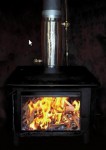In order to get a good accurate measurement of firewood, it will help if it is stacked with square corners and even straight sides. An uneven pile will require some estimating and the measurement will not be as accurate.
With a well stacked pile you simple measure the height length and width in feet and multiply them together. This gives you the cubic feet volume. Since a cord is 128 cubic feet you divide your figure by 128 and to find out how many cords of wood you have.
Example: The standard dimensions of a cord is 4x4x8 feet. Multiply those numbers together and you get 128 cubic feet which is one cord. 4x4x4 is 64 cubic feet divided by 128 is .5 or 1/2 cord. You can also use this simple cord of wood calculator.
If your stacks are not square and even you will have to do some averaging and estimating. For example, if the height varies along the stack take several height measurements in different places along the length of the stack and take the average to use that for your calculation. If the ends of the stack are sloped instead of vertical you will have to estimate where to start measuring the length of the stack.
If the pieces of firewood vary in length, this can make getting an accurate measurement more difficult. Since the length of the pieces determine the with of a row or multiple rows stacked side by side then the with of a row will be uneven. In this case take several measurements to come up with the average length of your pieces to get the width of the stack.
A heaping pile of firewood is really not practical to measure since heaping piles tend to have random dimensions. This can take more serious geometry to figure out the volume. If I try to explain how to do that here I will probably only confuse us both. If you really want an accurate measurement it might be easier to stack it than figure it out. That is if it isn’t a huge pile.
Firewood that is loosely thrown into a square sided container like a pickup bed or a shed can be measured the same as wood that is stacked. Just measure the length with and height and multiply them. If the top of the pile is uneven make an estimate of what the height would be if it was even.
Firewood that is loosely thrown into a pile has more air space between the pieces so a loose cord will take up more volume than a stacked cord. For a loose cord, instead of dividing your cubic foot volume by 128, divide it by 180 cubic feet.
This 180 cubic feet figure is a rough estimate and can vary by how loosely it is thrown together so only consider the measurement of a loose cord to be an estimate and not an accurate way to measure a legal cord.
If you have a question or need something clarified feel free to ask in the public comment section below.
